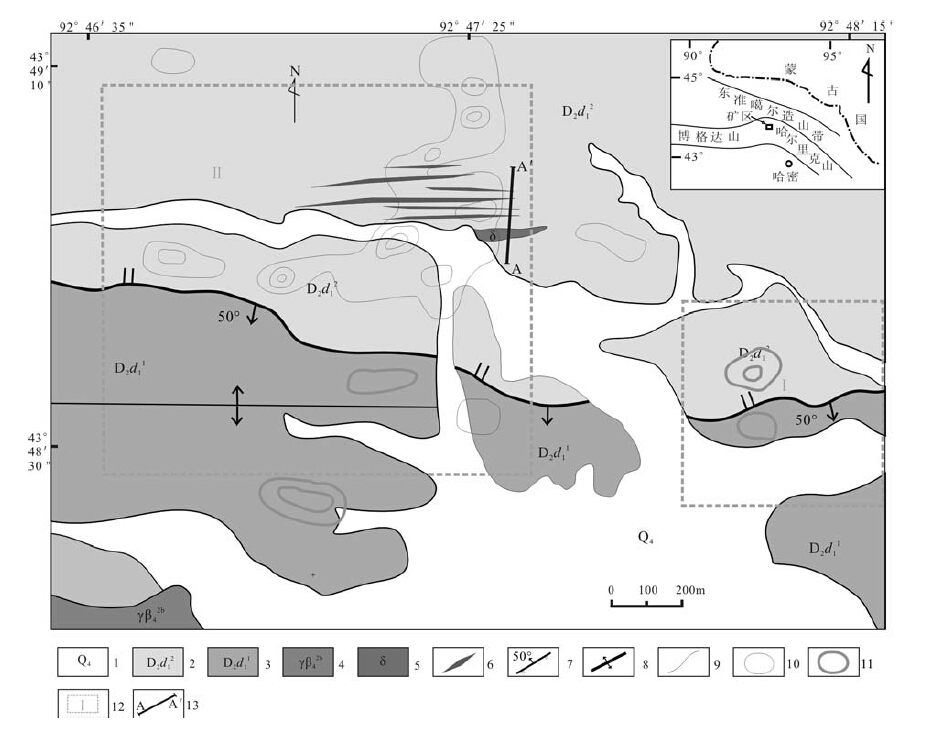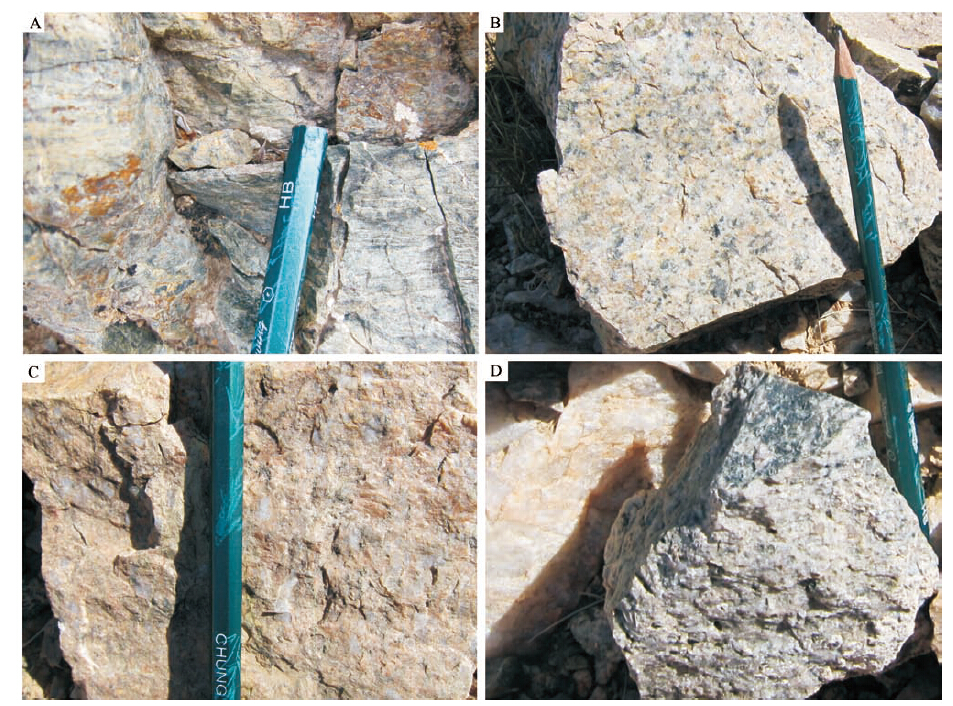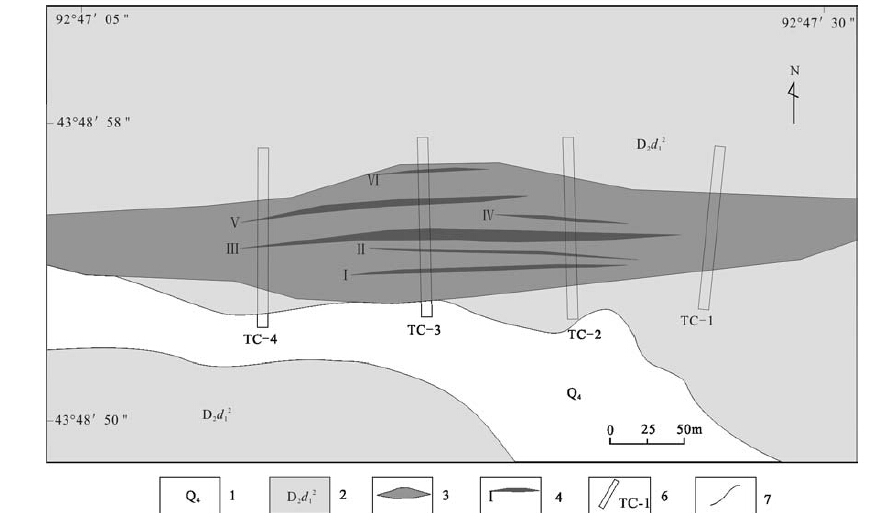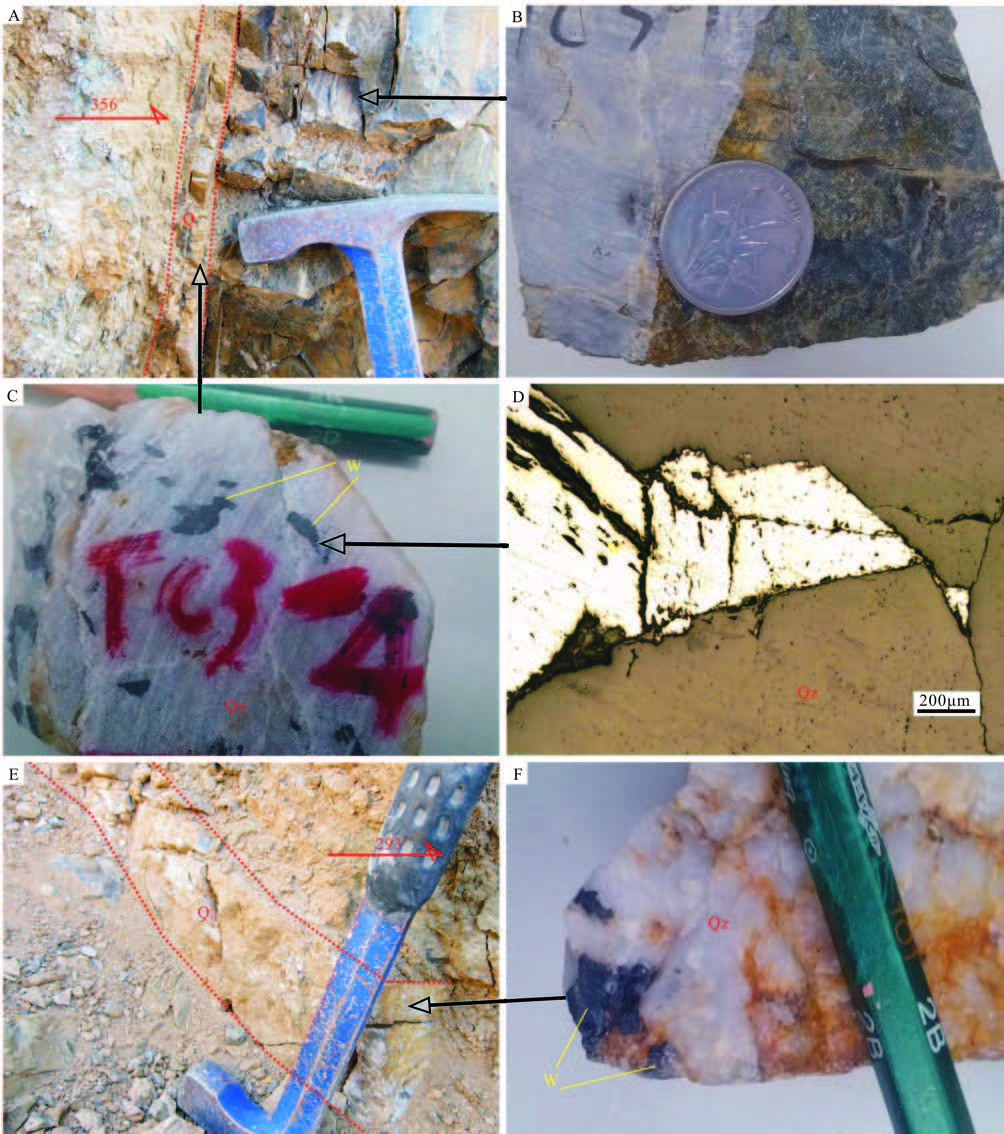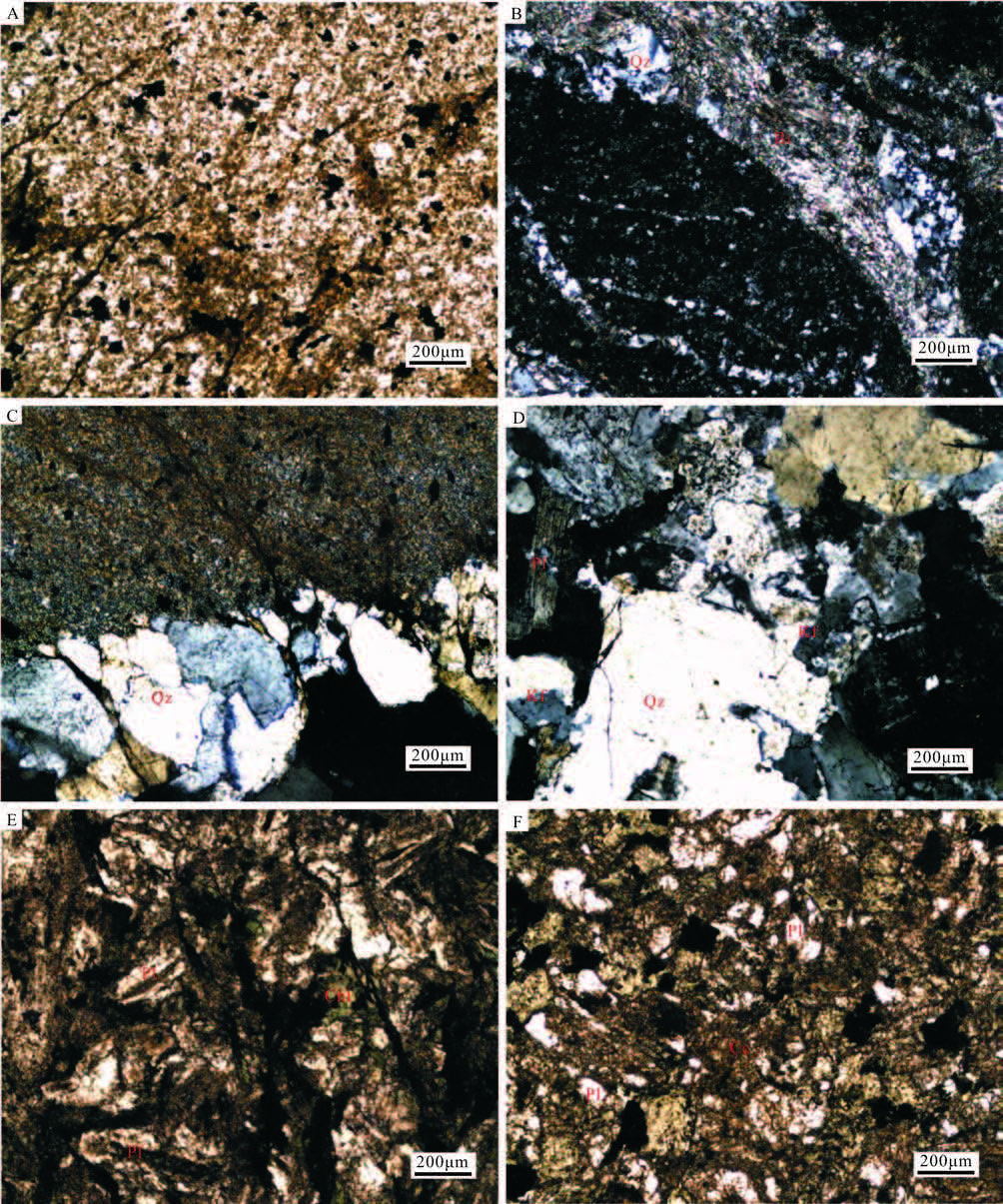Geological characteristics and genetic mechanism of the Xiaojiashan tungsten deposit in the Barkol district, Xinjiang
-
摘要:
小加山钨矿区位于东准噶尔成矿区中部南缘,处于博格达-哈尔里克构造带上。构造位置上矿区处于哈尔里克复式背斜中,构造线方向以EW向为主。矿区出露地层主要为中泥盆统大南湖组第一亚组第一段(D2d11)、和第二段(D2d12)。主要岩浆岩有石英闪长岩、黑云母二长花岗岩、钾长花岗岩及少量中酸性花岗闪长岩脉。矿体赋存于邻近海西晚期花岗岩侵入体附近的中泥盆统大南湖组第一亚组第二段(D2d12)的变质晶屑凝灰岩中。矿石类型为石英脉型黑钨矿石,有用金属主要为黑钨矿,黑钨矿石英脉分为灰色含钨石英脉和白色含钨石英脉2种。四极质谱分析法测得矿床流体包裹体气相成分以H2O、CO2为主,次为N2、CH4,此外还含有少量的Ar、C2H6,液相成分以Cl-、Na+为主,次为Ca2+,表明成矿流体主要为H2O-CO2-NaCl体系。矿床成因类型属于高温热液石英脉型黑钨矿床,矿体主要位于围岩裂隙构造。钨主要由侵入围岩地层中的地幔热液迁移富集而来,W元素迁移过程中,含钨络合物成矿流体分解进而沉淀成矿。
Abstract:The Xiaojiashan tungsten deposit, located at the southern edge of the central area of east Junggar, is one of the metallic deposits in Bogda-Harlik tectonic belt. The structural position of the deposit is in the Harlik double anticline and the tectonic line is mainly EW-striking. The regional strata are mainly composed of 1st and 2nd lithologic member of the 1st Subformation of Middle Devonian Dananhu Formation (D2d11, D2d12). The mining area has sporadic quartz diorite, moyite and a small number of intermediate-acid granodiorite veins. The orebodies occur in a late Hercian granite intrusion near the metamorphic crystal tuff which consists of the 2nd lithologic member of the 1st Dananhu Subgroup in Middle Devonian (D2d12), whose type is wolframite ores of quartz vein, and wolframite is the main useful metal. Tungsten-bearing quartz veins are divided into gray wolframite-quartz vein and white quartz vein. Quadrupole mass spectrometry reveals that fluid inclusions contain major gas phase contents of CO2, H2O and a little variable positive ion component of Ca2+. In addition, there is a little variable components of Ar, C2H6 in gas phase. Meanwhile, fluid inclusions contain major liquid phase contents of Cl-, Na+ and a little variable positive ion component of Ca2+. It can be inferred that the ore-forming fluid of the Xiaojiashan wolframite deposit is characterized by a CO2-rich, low salinity, and H2O-CO2-NaCl system. The origin of the Xiaojiashan wolframite deposit can be considered as a high-temperature hydrothermal quartz vein type deposit controlled by fissure structures. Wolframite-bearing ore veins are distributed mainly over fissure structures. A portion of tungsten must have been sourced from migration and enrichment of mantle hydrothermal intrusion in wall rock and strata. Therefore, W-bearing complexes ore-forming fluid decomposed in the migration process of W, and promoted the precipitation of W in the Xiaojiashan deposit.
-
致谢: 野外工作得到北京中色地科矿产勘查股份有限公司的帮助,审稿专家提出宝贵的修改建议,在此一并致以诚挚的谢意。
-
图 1 巴里坤及其周缘地区区域构造简图(据参考文献[5]修改)
Ⅰ1—东准噶尔造山带;Ⅰ2—博格达造山带;Ⅰ3—哈尔里克造山带;Ⅱ1—准噶尔盆地;Ⅱ2—吐哈盆地。1—断裂带;2—盆地边界;3—地质界线。区域断裂: F1—阿尔曼太断裂;F2—卡拉麦里-哈儿里克断裂;F3—博格达北缘断裂;F4—博格达南缘断裂;F5—迪坎尔-沁城断裂
Figure 1. Simplified regional structure map of Barkol and its surrounding areas
表 1 钨矿床 237 号线剖面岩石特点
Table 1 Profile rock characteristics of tungsten deposit along No. 237 line
样品号 样品名称 样品特征 HGX-B1 角砾凝灰岩 灰黑色,凝灰结构,块状构造,内夹杂黄白色角砾。主要由石英和长石组成,含少量粘土成分 HGX-B2 绿泥石化闪长岩 主要由斜长石、石英和镁铁质矿物组成。闪长岩呈墨绿色,细晶结构,块状构造,绿泥石化,褐铁矿化 HGX-B3 变晶屑凝灰岩 深灰色,变余凝灰结构,块状构造。主要矿物为石英、斜长石和绿泥石,次要矿物有绢云母。由中酸性凝灰质岩石、沉积凝灰岩经轻微变质作用形成,绿泥石化、硅化 HGX-B4 褐铁矿化石英脉 石英呈白色,油脂光泽,等粒变晶结构,块状构造,致密块状,褐铁矿化。石英脉中含黑色,具有金属光泽黑钨矿 HGX-B5 变晶屑凝灰岩 深灰色,变余凝灰结构,块状构造。主要矿物为正长石、石英和火山凝灰胶结物,次要矿物有黑云母。内有石英细脉穿插,石英体积分数为30% HGX-B6 硅质灰岩 深灰色,褐铁矿化,隐晶质结构,块状构造。主要矿物有石英、方解石,夹变余玻屑凝灰砂岩 表 2 石英包裹体气相成分分析结果
Table 2 Analytical results of gas phase composition of quartz fluid inclusion
样号 H2O N2 Ar* CO2 CH4 C2H6 H2S CO2/H2O TC2-3(石英) 93.41 0.121 0.009 5.977 0.416 0.059 - 0.064 TC2-5(石英) 96.33 0.078 0.012 3.269 0.259 0.047 - 0.034 TC3-2B(石英) 91.39 0.212 0.006 7.77 0.588 0.015 - 0.085 TC3-4(石英) 95.9 - 0.022 3.359 0.183 0.532 - 0.035 TC3-6(石英) 90.38 0.163 0.09 8.719 0.619 0.097 - 0.096 TC3-2B(黑钨矿) 89.63 0.184 0.0004 9.964 0.165 - - 0.111 TC3-4(黑钨矿) 91.65 0.221 0.022 7.723 0.363 - - 0.084 平均值 92.67 0.163 0.011 6.683 0.371 0.150 0.072 注:由中国科学院地质与地球物理研究所包裹体实验室测试;“-”未检出,“*”仅供参考;单位mol% 表 3 石英包裹体液相成分分析结果
Table 3 Analytical results of fluid phase composition of quartz fluid inclusion
样号 F* Cl* SO4 Na+ K+ Mg2+ Ca2+ Na+/Ca2+ TC2-3(石英) - 53.6 - 38.5 - - 1.57 24.522 TC2-5(石英) - 54.5 - 40.2 - - 1.15 34.957 TC3-2B(石英) - 58 - 42 - - 3.6 11.667 TC3-4(石英) - 51.4 - 36.7 - - 0.627 58.533 TC3-6(石英) - 65.5 - 48 - - 3.09 15.534 -
楼法生, 唐春花. 新疆巴里坤红井子地区石炭纪火山岩及其大地构造环境分析[J]. 新疆地质, 1995, 13(1): 67-76. http://www.cnki.com.cn/Article/CJFDTOTAL-XJDI501.006.htm 王伟健. 新疆巴里坤县大加山一带碱性花岗岩的特征及构造环境探讨[J]. 新疆地质, 1996, 14(2): 159-168. http://www.cnki.com.cn/Article/CJFDTOTAL-XJDI602.007.htm 杨志平. 新疆巴里坤县八墙子一带金铜成矿规律分析及找矿方向[J]. 华北国土资源, 2011, 2: 4-6. http://www.cnki.com.cn/Article/CJFDTOTAL-HBGT201102004.htm 新疆维吾尔自治区地质矿产局. 新疆维吾尔自治区区域地质志[M]. 北京: 地质出版社, 1993: 86-759. 王玉玺. 新疆博格达山东段晚古生代水系沉积物及成矿意义的研究[D]. 兰州大学硕士学位论文, 2010: 9-10. http://cdmd.cnki.com.cn/Article/CDMD-10730-2010131746.htm 新疆维吾尔自治区地质矿产局. 新疆维吾尔自治区岩石地层[M]. 武汉: 中国地质大学出版社, 1999: 20-140. 徐学义, 何世平, 王洪亮, 等. 中国两北部地质概论—秦岭、祁迮、天山地区[M]. 北京: 科学山版社, 2008: 93-95. 马瑞士, 叶尚夫, 王赐银, 等. 东天山造山带构造格架和演化[J]. 新疆地质科学, 1990, 2: 21-36. http://www.cnki.com.cn/Article/CJFDTOTAL-XJDZ201001004.htm Xiao W J, Zhang L C, Qin K Z, et al. Paleozoic accretionary and collisional tectonics of the eastern Tianshan (China): implications for the continental growth of central Asia[J]. American Journal of Science, 2004, 304: 370-395. doi: 10.2475/ajs.304.4.370 Xiao W J, Zhang L C, Qin K Z, et al. Paleozoic accretionary and collisional tectonics of the eastern Tianshan (China): implications for the continental growth of central Asia[J]. American Journal of Science, 2004, 304: 370-395. doi: 10.2475/ajs.304.4.370
Xiao W J, Han C M, Yuan C, et al. Middle Cambrian to Permian subduction-related accretionary orogenesis of Northern Xinjiang, NW China: Implications for the tectonic evolution of central Asia[J]. Journal of Asian Earth Sciences, 2008, 32: 102-117. doi: 10.1016/j.jseaes.2007.10.008 Xiao W J, Han C M, Yuan C, et al. Middle Cambrian to Permian subduction-related accretionary orogenesis of Northern Xinjiang, NW China: Implications for the tectonic evolution of central Asia[J]. Journal of Asian Earth Sciences, 2008, 32: 102-117. doi: 10.1016/j.jseaes.2007.10.008
顾连兴, 胡受奚, 于春水, 等. 博格达陆内碰撞带挤压-拉张构造转折期的侵入活动[J]. 岩石学报, 2001, 17(2): 187-198. http://www.cnki.com.cn/Article/CJFDTOTAL-YSXB200102001.htm 顾连兴, 胡受奚, 于春水, 等. 论博格达俯冲撕裂型裂谷的形成与演化[J]. 岩石学报, 2001, 17(4): 585-597. http://www.cnki.com.cn/Article/CJFDTOTAL-YSXB200104008.htm 崔盛芹. 论全球性中-新生代陆内造山作用与造山带[J]. 地学前缘, 1999, 6(4): 283-293. http://www.cnki.com.cn/Article/CJFDTOTAL-DXQY199904016.htm Sawkins F J. Metal deposits in relation to Plate-tectonics[M]. Berlin: Springer-Verlag, Second edition,1990. Sawkins F J. Metal deposits in relation to Plate-tectonics[M]. Berlin: Springer-Verlag, Second edition,1990.
宋鸿林. 燕山式板内造山带基本特征与动力学探讨[J]. 地学前缘, 1999, 6(4): 309-316. http://www.cnki.com.cn/Article/CJFDTOTAL-DXQY199904019.htm Han B F, He G Q, Wang S G. Post collisional mantle-derived magmatism, under plating and implications for basement of the Junggar basin[J]. Science in China(Series D), 1999, 42(2): 113-119. doi: 10.1007/BF02878509 Han B F, He G Q, Wang S G. Post collisional mantle-derived magmatism, under plating and implications for basement of the Junggar basin[J]. Science in China(Series D), 1999, 42(2): 113-119. doi: 10.1007/BF02878509
何国琦, 李茂松, 刘德权, 等. 中国新疆古生代地壳演化及成矿[M]. 乌鲁木齐: 新疆人民出版社, 1994: 1-437. 顾连兴, 胡受奚, 于春水, 等. 东天山博格达造山带石炭纪火山岩及其形成地质环境[J]. 岩石学报, 2000, 16(3): 305-317. http://www.cnki.com.cn/Article/CJFDTOTAL-YSXB200003000.htm 王银喜, 顾连兴, 张遵忠, 等. 博格达裂谷双峰式火山岩地质年代学与Nd-Sr-Pb同位素地球化学特征[J]. 岩石学报, 2006, 22(5): 1215-1224. http://www.cnki.com.cn/Article/CJFDTOTAL-YSXB200605013.htm 方国庆. 东天山古生代板块构造特点及其演化模式[J]. 甘肃地质学报, 1994, 3(1): 34-40. http://www.cnki.com.cn/Article/CJFDTOTAL-GSDZ401.003.htm 马瑞士, 王赐银, 叶尚夫, 等. 东天山构造格架及地壳演化[M]. 南京: 南京大学出版社, 1993. 孙桂华, 李锦轶, 高立明, 等. 新疆东部哈尔里克山闪长岩体锆石SHRIMP U-Pb定年及其地质意义[J]. 地质论评, 2005, 51(4): 463-469. http://www.cnki.com.cn/Article/CJFDTOTAL-DZLP200504018.htm 孙桂华, 李锦轶, 朱志新, 等. 新疆哈尔里克山古生代以来构造变形及构造演化[D]. 中国地质科学院地质研究所博士学位论文, 2007. Davies G R, Macdonald R. Crustal in fluences in the Petrol genesis of the Naivasha basalt-comendite complex: Combined trace element and Sr-Nd-Pb isotope constraints[J]. Petrol, 1987, 28(6): 1009-1031. doi: 10.1093/petrology/28.6.1009 Davies G R, Macdonald R. Crustal in fluences in the Petrol genesis of the Naivasha basalt-comendite complex: Combined trace element and Sr-Nd-Pb isotope constraints[J]. Petrol, 1987, 28(6): 1009-1031. doi: 10.1093/petrology/28.6.1009
Cull J P, Oreilly S Y, Griffin W L. Xenoliths'. Geotherms and crustal models in eastern Australia[J]. Tectonophsics, 1991, 192: 359-366. doi: 10.1016/0040-1951(91)90109-6 Cull J P, Oreilly S Y, Griffin W L. Xenoliths'. Geotherms and crustal models in eastern Australia[J]. Tectonophsics, 1991, 192: 359-366. doi: 10.1016/0040-1951(91)90109-6
卢文忠, 刘亚娟. 浅析新疆双峰山金矿床地质特征及矿床类型[J]. 新疆有色金属, 2003, 4(S2): 9-11. http://www.cnki.com.cn/Article/CJFDTOTAL-XJYS2003S2004.htm 彭晓明, 莫江平, 郦今敖, 等. 新疆哈尔里克双峰山浅成低温热液金矿床的地质特征与成矿模式[J]. 矿床地质, 2004, 23(1): 101-106. http://www.cnki.com.cn/Article/CJFDTOTAL-KCDZ200401011.htm 陈仁义, 刘海光, 马文义, 等. 新疆琼河坝铜金矿化地质特征及成因机理[J]. 地质与勘探, 1995, 31(1): 26-31. http://www.cnki.com.cn/Article/CJFDTOTAL-DZKT501.005.htm 刘伟, 李新俊, 邓军. 东天山金窝子石英脉金矿床成矿流体和成矿物质的来源[J]. 中国科学(D辑), 2002, 32(增刊): 105-119. http://www.cnki.com.cn/Article/CJFDTOTAL-JDXK2003S2011.htm 朱和平, 王莉娟. 四极质谱测定包裹体中的气相成分[J]. 中国科学(D辑), 2001, 31(7): 586-590. http://www.cnki.com.cn/Article/CJFDTOTAL-JDXK200107007.htm 朱和平, 王莉娟, 刘建明. 不同成矿阶段流体包裹体气相成分的四极质谱测定[J]. 岩石学报, 2003, 19(2): 314-318. http://www.cnki.com.cn/Article/CJFDTOTAL-YSXB200302012.htm 卢焕章, 范宏瑞, 倪培, 等. 流体包裹体[M]. 北京: 科学出版社, 2004: 232. Higgins N C. Fluid inclusion evidence for the transport of tungsten by carbonate complexes in hydrothermal solutions[J]. Earth Science, 1980, 17: 823-830. https://www.researchgate.net/publication/237171985_Fluid_inclusion_evidence_for_the_transport_of_tungsten_by_carbonate_complexes_in_hydrothermal_solutions Higgins N C. Fluid inclusion evidence for the transport of tungsten by carbonate complexes in hydrothermal solutions[J]. Earth Science, 1980, 17: 823-830. https://www.researchgate.net/publication/237171985_Fluid_inclusion_evidence_for_the_transport_of_tungsten_by_carbonate_complexes_in_hydrothermal_solutions
Rios F J, Villas R N, Fuzikawa K. Fluid evolution in the pedra preta wolframite ore deposit, paleproterozoic musa granite, Eastern Amazon Craton, Brazil[J]. Journal of South American Earth Sciences, 2003, 15: 790-794. http://www.docin.com/p-1383537719.html Rios F J, Villas R N, Fuzikawa K. Fluid evolution in the pedra preta wolframite ore deposit, paleproterozoic musa granite, Eastern Amazon Craton, Brazil[J]. Journal of South American Earth Sciences, 2003, 15: 790-794. http://www.docin.com/p-1383537719.html
Drummond S E, Ohmoto H. Chemical evolution and mineral deposition in boiling hydrothermal systems[J]. Economic Geology, 1985, 80: 126-147. doi: 10.2113/gsecongeo.80.1.126 Drummond S E, Ohmoto H. Chemical evolution and mineral deposition in boiling hydrothermal systems[J]. Economic Geology, 1985, 80: 126-147. doi: 10.2113/gsecongeo.80.1.126
So C S, Yun S T. Origin and evolution of W-Mo producing fluids in a granitic hydrothermal system: geochemical studies of quartz vein deposits around the Susan granite, Hwanggangri district, Republic of Korea[J]. Economic Geology, 1994, 89: 246-267. doi: 10.2113/gsecongeo.89.2.246 So C S, Yun S T. Origin and evolution of W-Mo producing fluids in a granitic hydrothermal system: geochemical studies of quartz vein deposits around the Susan granite, Hwanggangri district, Republic of Korea[J]. Economic Geology, 1994, 89: 246-267. doi: 10.2113/gsecongeo.89.2.246



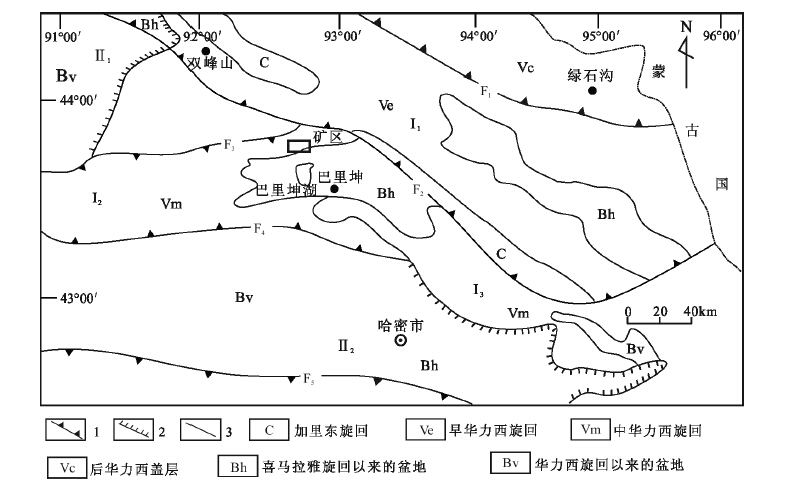
 下载:
下载:
